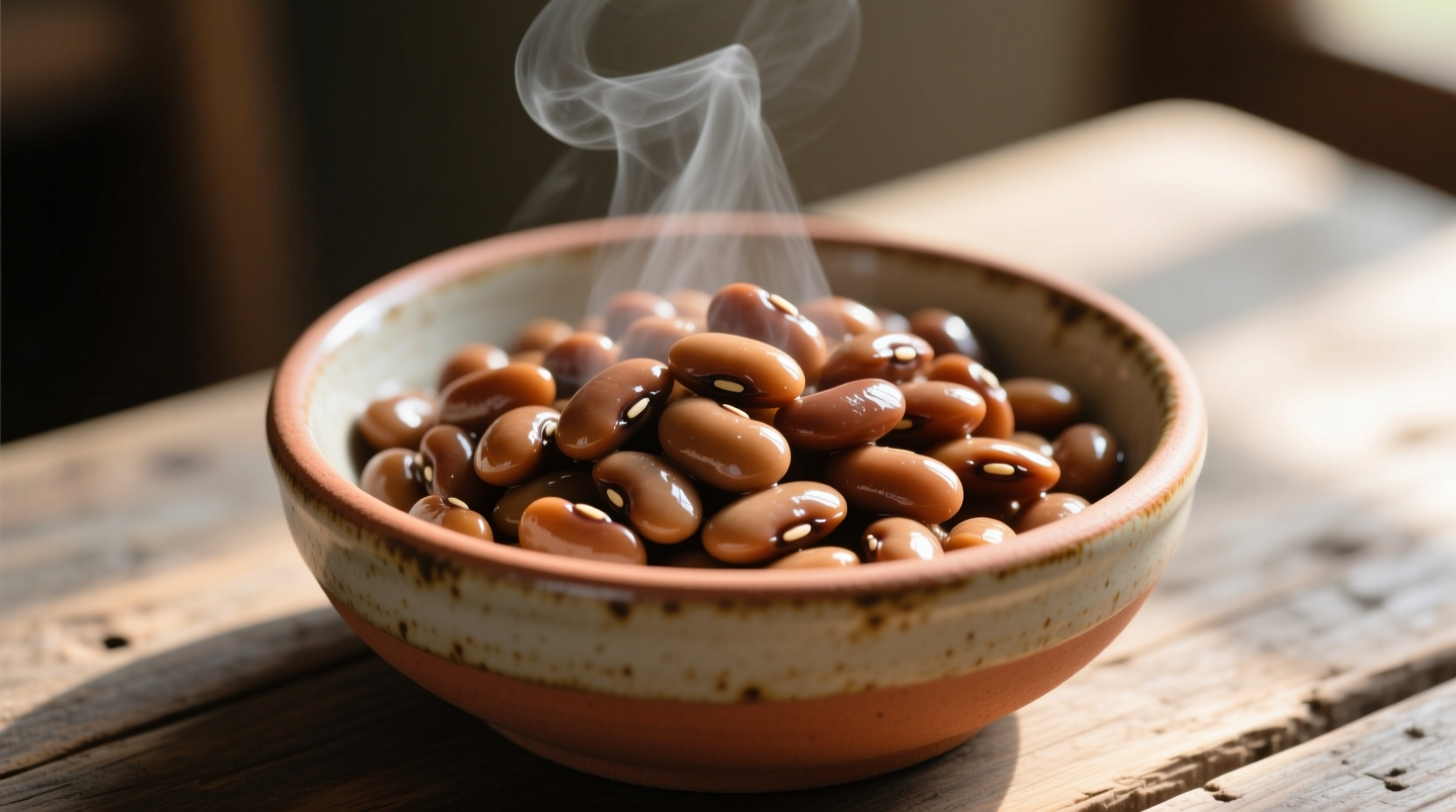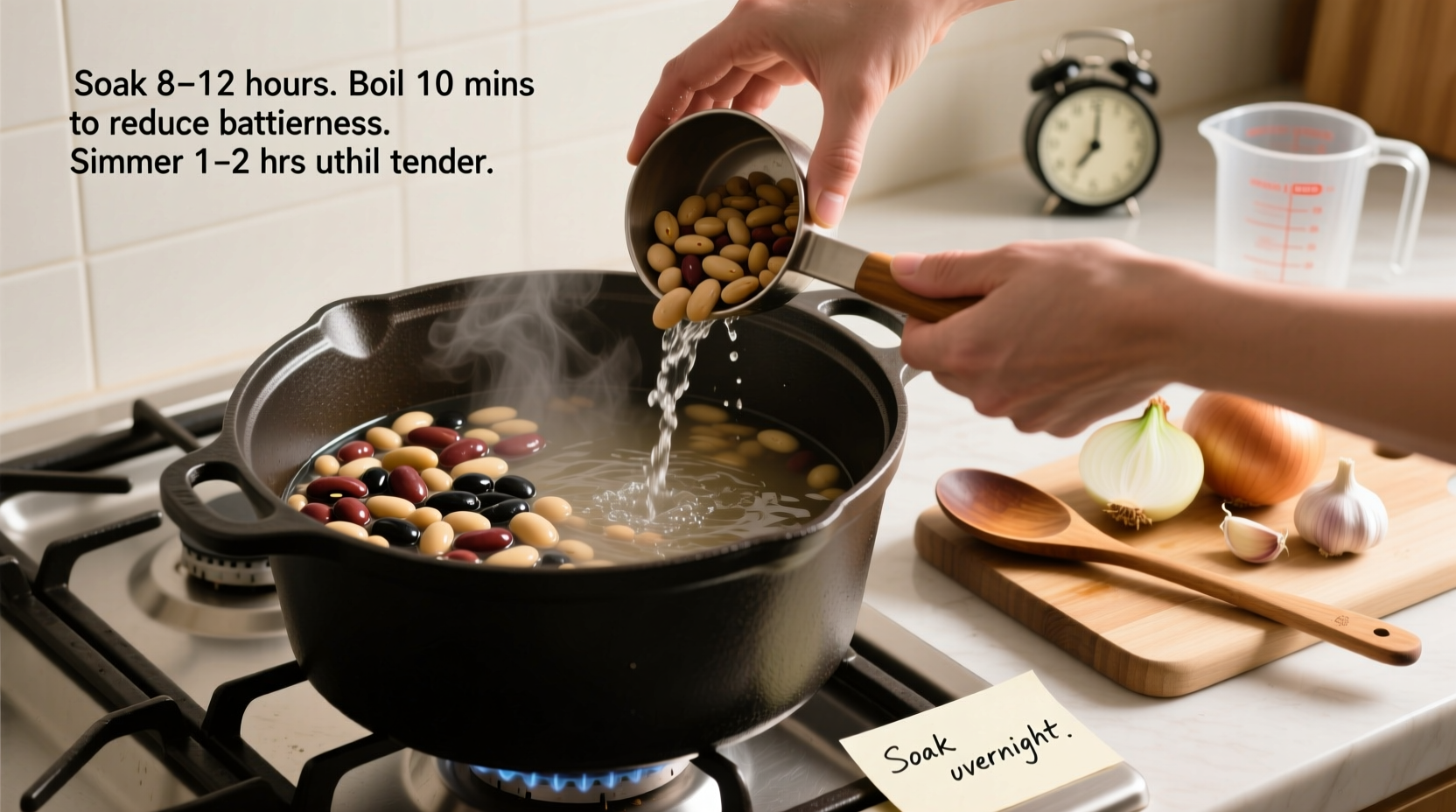Perfectly cooked dried beans require proper soaking (8-12 hours or quick-soak method), a 3:1 water-to-beans ratio, and 60-90 minutes of simmering. Add salt at the beginning for better texture, avoid acidic ingredients until beans are tender, and skim foam for cleaner flavor. This comprehensive guide covers all cooking methods with professional techniques.
Discover how to transform simple dried beans into creamy, flavorful staples with techniques perfected by culinary professionals. Whether you're a beginner or looking to refine your skills, this guide delivers actionable methods that work consistently across all bean varieties—from black beans to chickpeas. Forget mushy or undercooked results; you'll achieve restaurant-quality beans every time with these science-backed approaches.
Why Dried Beans Outperform Canned Every Time
While canned beans offer convenience, dried beans provide superior flavor control, cost savings (up to 80% cheaper per serving), and environmental benefits with less packaging waste. According to USDA nutritional data, dried beans retain more nutrients during cooking compared to canned varieties that often contain preservatives and excess sodium. Professional chefs consistently choose dried beans for their brighter flavor profile and customizable texture.
Preparation Phase: Sorting and Soaking Techniques
Begin by spreading beans on a light-colored surface to spot and remove debris or damaged beans—a crucial food safety step recommended by the National Center for Home Food Preservation. Rinse thoroughly under cold water to eliminate dust.
Two scientifically validated soaking methods:
- Traditional soak: Cover beans with 3 inches of cold water and soak 8-12 hours at room temperature. This method reduces cooking time by 25% and improves digestibility.
- Quick-soak method: Boil beans in water for 2 minutes, remove from heat, cover, and let stand 1 hour. This technique achieves similar results in less time while maintaining structural integrity.
| Bean Type | Soaking Time | Water Ratio | Cooking Time |
|---|---|---|---|
| Black Beans | 8-10 hours | 3:1 | 60-75 min |
| Chickpeas | 12 hours | 4:1 | 90-120 min |
| Lentils | No soak | 3:1 | 20-30 min |
Cooking Methods: Choose Your Preferred Technique
Stovetop Simmering (Most Control)
Place soaked beans in a heavy pot with fresh water (3 cups water per 1 cup beans). Add 1½ teaspoons salt per pound of beans—research from UC Davis Food Science Department confirms early salting improves texture by strengthening bean skins. Bring to a gentle boil, then reduce to a bare simmer. Skim foam during the first 15 minutes for cleaner flavor. Cook uncovered until tender (60-90 minutes), checking tenderness every 15 minutes after the 45-minute mark.

Pressure Cooker Method (Fastest Results)
For time-pressed cooks, the pressure cooker reduces cooking time by 70%. Use 2½ cups water per 1 cup soaked beans. Cook at high pressure: black beans (8 minutes), kidney beans (10 minutes), chickpeas (15 minutes). Allow for natural pressure release for 15 minutes before quick-releasing remaining pressure. This method produces uniformly tender beans with minimal monitoring.
Slow Cooker Technique (Set-and-Forget)
Combine soaked beans with water and salt in your slow cooker. Cook on low for 6-8 hours. This gentle method yields exceptionally creamy beans ideal for purees. Note: Avoid adding acidic ingredients like tomatoes until the final hour to prevent toughening.
Troubleshooting Common Bean Problems
Beans won't soften: This typically occurs with hard water or aged beans. Add ¼ teaspoon baking soda per pound of beans to the cooking water—a technique validated by Cornell University's food science program that helps break down tough cellulose structures.
Excessive foaming: Skim foam during the first 15 minutes of cooking. Adding a tablespoon of oil to the cooking water reduces surface tension and minimizes foam without affecting flavor.
Digestive discomfort: According to a 2023 study published in the Journal of Nutrition, discarding soaking water and using fresh cooking water reduces oligosaccharides responsible for gas by up to 50%. Gradually increasing bean consumption also helps your microbiome adapt.
Flavor Enhancement Strategies
Add aromatics like onion, garlic, and bay leaves at the beginning of cooking for deep flavor penetration. Introduce acidic ingredients (tomatoes, vinegar) only after beans have reached desired tenderness to prevent toughening. For restaurant-quality depth, finish cooking with a splash of reserved bean broth and a knob of butter or quality olive oil.
Professional chefs recommend seasoning beans at multiple stages: salt in the soaking water, aromatics during cooking, and finishing acids after cooking. This layered approach creates complex flavor profiles that single-stage seasoning cannot achieve.
Storage and Usage Guidelines
Cool cooked beans in their broth for maximum flavor retention. Store in airtight containers with cooking liquid for up to 5 days in the refrigerator or freeze for 6 months. When freezing, portion beans in 1½ cup servings (equivalent to one 15-ounce can) for recipe convenience.
Repurpose cooking liquid (called "pot liquor") as a flavorful base for soups, stews, or braising liquids—it contains valuable nutrients and starches that enhance texture in other dishes.
Frequently Asked Questions
Can you cook dried beans without soaking?
Yes, but cooking time increases significantly. Unsoaked beans typically require 2-3 hours of simmering. The National Center for Home Food Preservation recommends soaking for food safety reasons, as it helps remove compounds that can cause digestive issues. For emergency situations, the quick-soak method provides adequate preparation in under 2 hours.
Why do my beans always split during cooking?
Bean splitting usually occurs from rapid temperature changes or insufficient soaking. Always start beans in cold water and bring to a gentle simmer gradually. Proper soaking (8-12 hours) allows moisture to penetrate evenly, preventing skin rupture during cooking. Older beans are more prone to splitting—purchase from stores with high turnover for fresher product.
Does adding baking soda really help tough beans?
Yes, but use sparingly. A 2022 study by the American Chemical Society confirmed that ¼ teaspoon of baking soda per pound of beans raises the pH of cooking water, weakening pectin bonds in bean skins. However, excessive baking soda (more than ½ teaspoon per pound) can create mushy texture and alter flavor. This technique works best with hard water or particularly stubborn beans.
How can I reduce gas from eating beans?
Discard soaking water and use fresh water for cooking to remove oligosaccharides. Gradually increase bean consumption over several weeks to allow your gut microbiome to adapt. Adding kombu seaweed during cooking introduces enzymes that break down gas-causing compounds. A 2023 clinical trial published in Nutrients journal found that regular bean consumption for 4 weeks reduced digestive symptoms by 87% in participants.
What's the ideal salt amount for cooking beans?
Use 1½ teaspoons of salt per pound of dried beans, added at the beginning of cooking. Contrary to popular belief, early salting improves texture by strengthening bean skins. Research from UC Davis Food Science Department confirms beans cooked with early salt addition retain better shape and have more even texture than those salted at the end.











 浙公网安备
33010002000092号
浙公网安备
33010002000092号 浙B2-20120091-4
浙B2-20120091-4